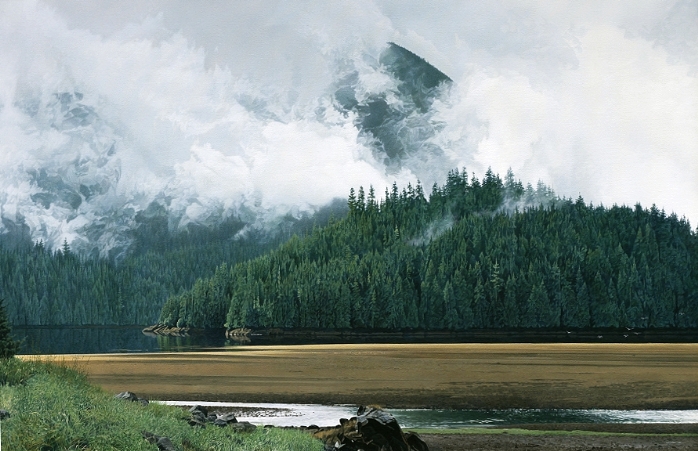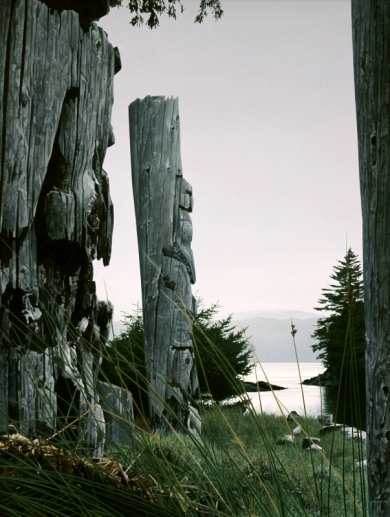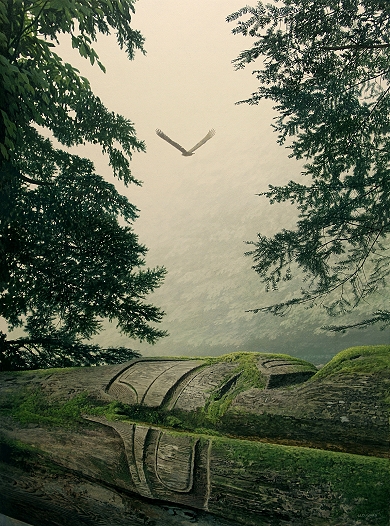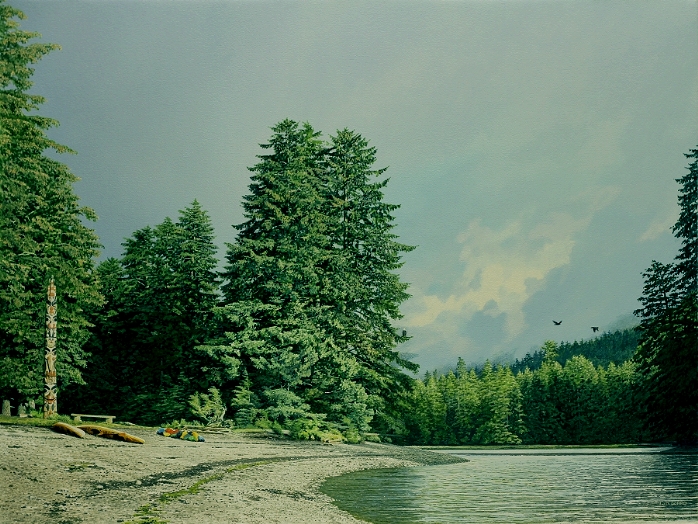| Currently Gallery Original Prints Books Bio Contact Home |
| Eyes Of Society |
Art, Traditional Knowledge, and the Watchmen of Haida Gwaii |
|
Below are the four works of W. David Ward; two inspired by the original expedition, in 1988, and two from the subsquent 'ReEncounter' Expedition, in 2016. The images and text below (including excerpts from the artist's journal) provide a glimpse of the mysterious encounter which, almost thirty years later, has united the creative spirit of an ever expanding group of independent artists. The works here explore the theme of sustainability (balance), one of six key Haida values, explored in the documentary and the work of the five other artists who part of the 2016 kayak expedition: |
'Spirit of the Hills' |
 |
"Spirit Of The Hills" 32" x 48 " – Acrylic on Canvas – 1989 |
|
Journal entry, 1988: |
'As the clouds lifted, an ethereal light swept across the tidal flats and over the mist shrouded hills. Curls of vapour, like spirits dancing through the tree tops, shrank into the shadows or swirled off into thin, clear air, as warm morning light washed across the forested slopes' |
|
|
|
'Carved In Memory" |
|
Journal entry, 1988: |
'We were able to locate the island’s natural harbour from some distance offshore, and as we approached, the totems of Ninstints village came into view. These ghostly grey figures stood in long grass, just back from the water’s edge, their stoic faces staring blankly out to sea. A raven cast a quizzical glance our way from atop one of the taller poles, then glided off into the forest shadow as our boats touched the shingle beach...
Embodiments of the spirit world watched over this abandoned village. For more than a hundred years the raven, the eagle, the killer whale, the frog and numerous other spirit guardians, have stood at the doorways of these Haida long-houses; and now, although the buildings themselves are almost gone, the spirits still keep vigil, as if holding the modern world at bay.' These most iconic works of Haida monumental art are central to this culture. They are central, also, to the idea of sustainability; for these works to be created there must be a supply of suitable trees. |
 |
"Carved In Memory" 29¾" x 22¾" – Acrylic on canvas – 1989 |
The sustainability of any culture, in the end, depends on the sustainability of the environment that supports it. The people of Easter Island, for instance, deforested themselves out of existence; but this was one little island, very much isolated from the rest of the world. Today, in a 'globalized' world, this dynamic has been reversed: The sustainability of the environment, in fact, depends on the culture it supports. It is not at all clear that we're not making the same mistakes (on a global scale now) that the people who once inhabited Easter Island made – before they were forced to move on. Unfortunately, today, in our 'fully-integrated world', we have no where else to move. The culture here however, in Haida Gwaii, was one of those ancient cultures that actually understood the importance of living in a balanced, sustainable way, within the natural environment. There was an added poignancy then, on the occasion of my first encounter with this place. But the Haida people were not forced move on; they are still here, and they may have one or two things to teach us. The totems of SGang Gwaay llnagaay (Nintints) have been preserved just long enough, it would appear, to see a cultural revival. When the ReEncounter group arrived in this place in 2016 (twenty-eight years after my first visit) the poles, though impressive as ever, had deteriorated somewhat – particularly when compared to those taken away and encapsulated in climate controlled, museum environments. The important point though, was that they had not been removed from this place. These poles were not museum artifacts – memories of a culture removed – they were the embodiment of a living culture, and a connection to the land. Those 'ghostly grey figures', as I viewed them in 1988, had become a symbol of continuity. A 'blank stare' was not what I saw this time; it seemed that a new life stirred behind those weathered eyes. Not too far to the north, in Windy Bay – where the modern world had, in fact, been held at bay – a 'renaissance' was underway. |
|
'ReEncounter – Spirit Free' 2017 |
|
Based on a Journal entry after a short visit to Tanu in 1988: |
“Mike?” I called, taking a few steps forward. There was no reply, just the suggestion of a figure, stationary now, beyond a tangled deadfall. I called again, and pushed forward through the branches. The hemlock whipped my face and snagged my arms. I turned my head and shielded the lens of my camera. Eventually the foliage gave way and I burst into a small opening where sunlight filtered through the canopy. The water was not far ahead, but a fallen tree, suspended waist height in the branches, barred my way. Oddly, the bark had been stripped away, and as I went to scramble over it a familiar design caught my eye.
There, in the shadows, as yet incomplete, it seemed – as if the artist had simply put down his tools and walked away – was a distinctive Haida carving. Just a design, no figurative work – it seemed strange that such a thing would have been left behind. This unknown artist had left his mark however, like a signature, for someone to findI took one last photograph; then stood for a time, watching and listening. The woods were still and silent. |
 |
"ReEncounter – Spirit Free" 23" x 17" – Acrylic on canvas – 2017 |
It was clear after a while that I was alone again. Lost in thought I headed back toward the beach. This was a poignant place, and a tragic place, but it was uplifting too. Any last doubts I might have had about pursuing my own art had been dispelled. A civilization had come and gone in these islands on the edge of the world, in this village at least, and all that remained – having withstood the voracious forces of nature and time – was a work of art; unsigned, undated, but timeless. |
|
The Tanu village site, in 1988, was not what it is today. Thick, dense forest had grown in and there was almost no open ground. There were no watchmen on site at this time, and the last pole standing, which had been called the 'sentinel' (by those looking for the village as they sailed past), had long since fallen down (during the winter of 1967-68). Some believed that the pole had been hauled off; just as the Thunderbird that once sat atop had 'disappeared', when it dislodged and fell to the ground. The poles from this site in particular are prized by museums around the world (and now stand in such institutions as the Smithsonian, The Royal Ontario Museum, the Museum of Civilization, the Field Museum – over thirty of them all together) and the last pole standing, a Killer Whale (though not as elaborate as the others), might still have been sought after. |
|
" Windy Bay Legacy" 2018 |
 |
"Windy Bay Legacy" 14" x 18" – Acrylic on Canvas – 2018 |
|
On the very last day of the 1988, South Moresby kayak trip, the first week in September, our group of four paddled from Hot Spring Island to Tanu (and back). Along the way, we stopped off at Windy Bay, Lyell Island. The salmon were running; struggling past and swarming over one another, as they fought their way upstream. There were such numbers of salmon running that I almost believed those old time accounts of the first Europeans in the 'new' world, who said one might step out of a boat and walk on the backs of fish, they were so thick in the water. What fascinated me though, was the role these fish played in the ecosystem. Not only were these creatures food for the inhabitants of this place (human and animal), but once they made their way into the forest to spawn, their bodies became a source of nutrition for the trees too, which grew to an astonishing size along the river banks. |
To receive regular bi-monthly updates, please email: contact @ wdavidward.com |
© W. David Ward All rights reserved |

